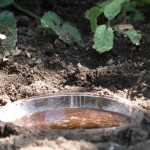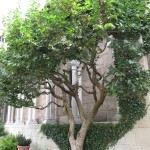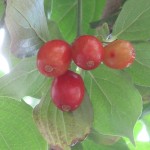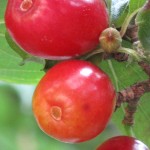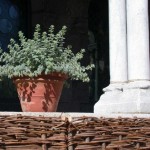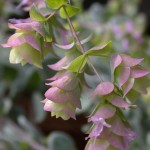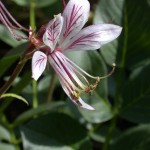Archive for August, 2010
Monday, August 23, 2010
Above, left: The great gray slug, also known as the leopard slug because of the spots and streaks on its mantle, at home in Bonnefont garden. These nocturnal garden pests are not normally seen during daylight hours. This specimen was spied early one morning, and posed to have his-her portrait taken (slugs are hermaphrodites). Center: When fully extended, the adult slug can reach an impressive length. Right: A single strategically placed slug trap baited with beer will attract quite a few slugs. Photographs by Corey Eilhardt.
The great gray slug (Limax maximus) is also commonly known as the leopard slug because of the characteristic dark spotting on the mantle which covers the upper part of its body; the lower part of its body, known as the foot, is often streaked or striped. Leopard slugs vary in color from brownish green to gray, with whitish undersides. Adult slugs range from 4 to 8 inches in length. Read more »
Tags: carnivore, clary sage, detrivore, gastropod, great gray slug, herbivore, leopard slug, Limax maximus, malacologist, mandrake, mollusc, pest, Salvia sclarea, slug, slug trap, stout
Posted in Gardening at The Cloisters, Plants in Medieval Art | Comments (1)
Friday, August 13, 2010
Above, from left to right: A mature cornelian cherry (Cornus mas) established against the east wall of Bonnefont garden; the foliage of Cornus mas is typical of the dogwood family to which it belongs; the tart red fruits, known as cornels, don’t ripen fully until after they fall from the tree in late July and early August. Photographs by Corey Eilhardt.
A native of dry, deciduous forests in central and southern Europe and western Asia, the cornelian cherry is a relative of our own flowering dogwood, Cornus florida. The fruit of the cornelian cherry is classified botanically as a drupe, as is the fruit of the true cherry, Prunus cerasus, but the two plants are in no way related. Although the fruits are unfamiliar to Americans, Cornus mas is very widely grown in this country as a small ornamental tree or as a multi-stemmed shrub, prized for the host of little yellow blossoms that veil the naked stems and branches in early March. Read more »
Tags: acorn, Alan Davidson, cherry, Circe, cornel, cornelian, Cornus florida, cornus mas, Dioscorides, drupe, Giacomo Castelvetro, Hildegard von Bingen, Homer, Hortus Sanitatis, kizilchik, Lee Reich, medlar, Prunus cerasus, quince
Posted in Food and Beverage Plants, Medicinal Plants | Comments (5)
Friday, August 6, 2010
Above: The left and center image show the true or “right dittany” of Crete (Origanum dictamnus), a tender Mediterranean species grown in pots in Bonnefont garden. This pretty relative of the culinary oreganos is endemic to the island, and is found growing wild only in the mountains there. The small, purplish-pink flowers are borne on long-lasting bracts in late summer and fall. The image on the right shows Dictamnus albus, known as white dittany or fraxinella, which is a botanically unrelated species. Medieval herbalists seem to have transferred both the name and the??marvelous properties that the ancients ascribed to true dittany to this herb.
Origanum dictamnus, with its round, woolly gray leaves,??rosy??bracts and delicate purplish-pink flowers, is the prettiest of the tender medieval species grown in pots in Bonnefont garden, and the most difficult for us to grow. One of a number of species endemic to the mountains of Crete, the wild plant is only found growing in the crevices of limestone gorges and ravines (see image). Known as diktamnon in Greek, it is said to be named after Mount Dikti. Read more »
Tags: Aeneas, antidote, Aristotle, artemidon, Artemis, Bonnefont Garden, Cos, Crete, diktamnon, Dioscorides, Hellmut Baumann, Hippocrates, Mount Ida, Origanum dictamnus, snake, snakebite, Theophrastus, venom, Venus, Virgil, William Turner
Posted in Fragrant Plants, Gardening at The Cloisters, Medicinal Plants | Comments (1)


